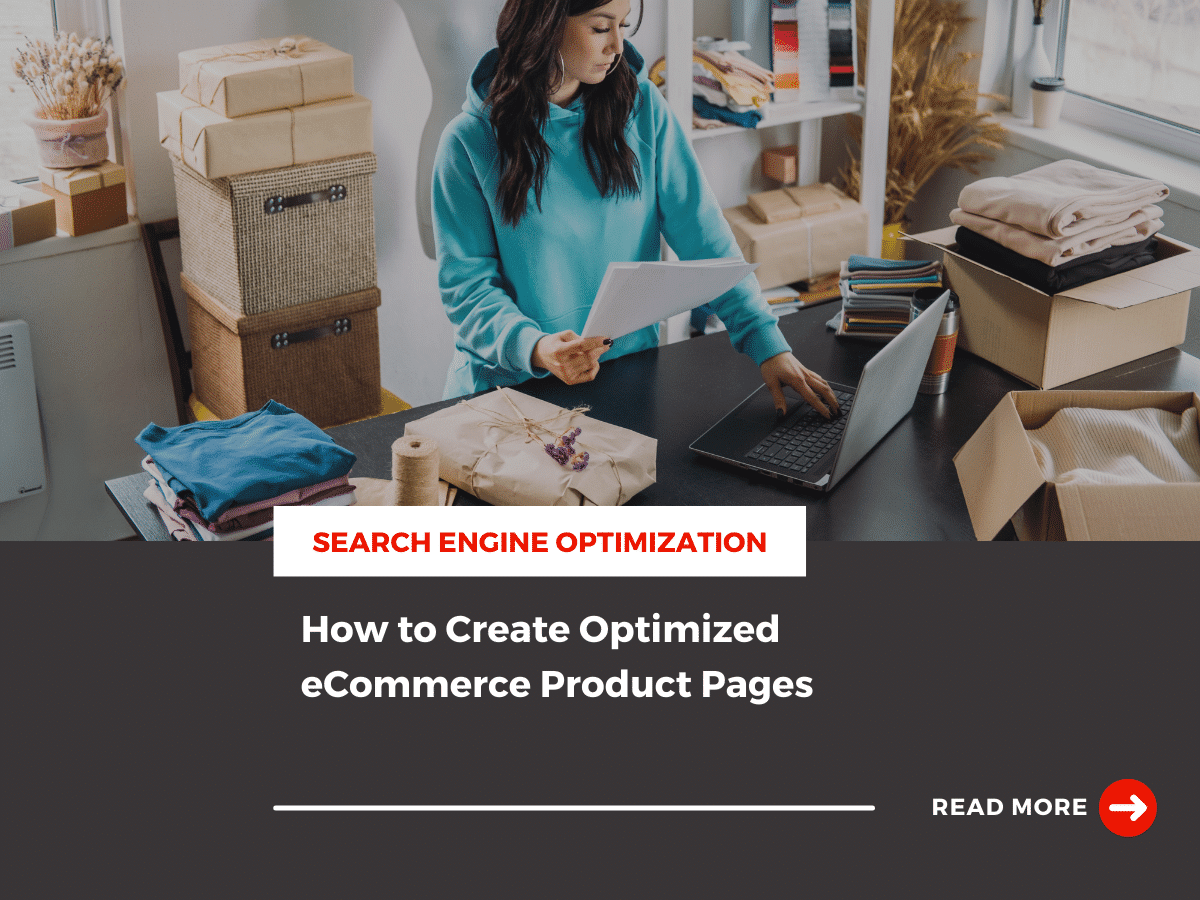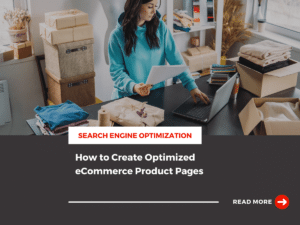Product pages are a vital aspect of any eCommerce business. Without high-quality photos and SEO-optimized content, you’ll never get the web traffic you desire to reach your revenue goals and build connections with prospects.
To maintain your competitive edge and ensure your products outrank your competitors in the SERPs, you’ll need to implement the best practices for SEO for eCommerce product pages.
In this article, we’ll look at product page optimization tips you can use to improve your product pages and help your content rank higher on the search engine results page.
Here’s everything you need to know:
1. Optimize Your Metadata
Metadata is backend information embedded into the HTML code of your product page. This data provides more context to the content of your pages and helps search engines decide where your pages should rank on the SERPs.
The two main meta components are your meta title tag and description tag. Over the years, the amount of characters used in the metadata has shrunk. The average title tag is 41.77 characters, and the metadata is 151.39. Auditing and optimizing your title tags to align with the trends can help them rank higher and improve your searchability.

Credit: Abercrombie
2. Add Customer Reviews
Customer reviews can help grow customer confidence. They provide authentic insight into the products you offer and the experiences your current customers have with them.
Without customer reviews for each product you offer, web visitors may not want to make a first-time purchase. This can lead to high abandon cart rates and low conversions. To avoid this, you’ll want to ensure each product page has its own review section.
You can also set up a customer journey to ask current customers to leave a review one to two weeks after purchasing. This will ensure your website has a steady flow of new and insightful views funneling into your product pages.
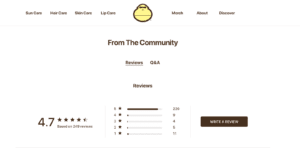
Credit: Sunbum
3. Include a More Items to Consider Section
Adding a “More Items to Consider” section on the product page can help improve the customer experience and keep individuals engaged with your offerings.
While they may have clicked on a specific product on Google or Bing, it may not be what they were looking for. The “More Items to Consider” section will keep them shopping for more, reducing your bounce rate and pushing users through your sales funnel naturally and organically.
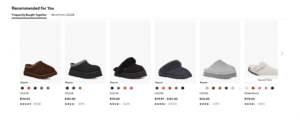
Credit: Nordstrom
4. Utilize Pop-ups to Drive Conversions
Pop-ups are marketing tools you can use to entice customers with special offers and discounts. They are also great for capturing emails and funneling prospects through your sales funnel. Even though web visitors might not make a purchase that day, you can continue to nurture the lead with an email series in the coming weeks.
When adding pop-ups to your website, you want to ensure they’re fully optimized for SEO and never disrupt the user experience. The pop-up should be easy to close and relevant to the consumer. The product page content should still be easily readable and accessible.

Credit: Dick’s Sporting Goods
5. Add Social Proof to the Page
Social proof is a great way to build rapport with your prospects and increase customer confidence. Popular types of social proof include user-generated content, endorsements, reviews, and case studies. These content types can help establish credibility and improve your conversion rate.
6. Include a FAQ Section
An FAQ section can help answer customers’ questions or concerns in real-time. It will improve the user experience, and with the right keywords and topics, it can help you rank higher on the SERPs. When you add an FAQ for your SEO for product pages, you’ll want to include relevant, commonly asked questions and use an FAQ schema. You’ll also want to ensure you add the necessary keywords and provide clear, concise responses to each question.
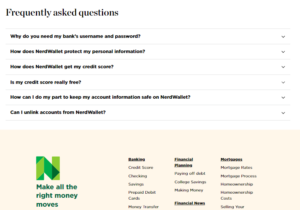
Credit: Nerd Wallet
7. Optimize Your Website for Mobile Devices
Google uses a mobile-first indexing approach. This is because mobile devices are quickly becoming the new norm for everyday web searches and shopping online. There are many best practices for product page SEO and mobile-friendly SEO to keep in mind to ensure your content ranks and provides the best user experience. If you don’t have an app, you’ll want to ensure your product pages are optimized for the mobile experience and have a responsive web design.
8. Include a Call-to-Action
A clear, consistent call-to-action is essential to SEO for eCommerce product pages and conversions. Here are a few tips for keeping your CTAs simple yet actionable.
- Use action-driven words like ADD TO CART or BUY NOW
- Make sure the button placement is above the fold
- Consider including a secondary CTA for current customers to leave a review
- Keep the CTA simple and consistent
- Make sure the CTA doesn’t blend in or go unnoticed
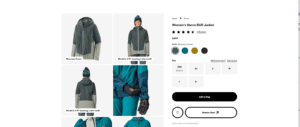
Credit: Patagonia
9. Add Keyword-Rich Product Descriptions
Think of keywords as your driving force for ranking higher in the SERPs. The product descriptions you include should be detailed and include relevant keywords that align with your prospect’s search habits.
When adding keywords to your product descriptions, you’ll want to make sure the content for each product is unique and that you don’t overuse the keywords. Make sure you add your target keywords in the first 200 words, as well as the metadata.
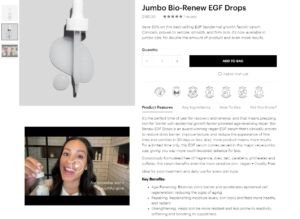
Credit: Glo Skin Beauty
10. Include High-Quality Photos and Videos
Shopping online isn’t always easy. Customers want to envision themselves with your products before they make a purchase. With high-quality photos and videos, you can truly show the value of your products and persuade prospects to purchase. Consider also adding user-generated content and images with an authentic feel.

Credit: The Reformation
Test Your Current Product Page SEO Performance
Once you make meaningful product page SEO optimizations, you’ll want to test your website and ensure the changes have an impact. Here’s how:
- Send out surveys asking for customer feedback
- Read and respond to all customer reviews
- Use heatmaps to better understand customer interactions
- Consider A/B testing different elements on the product page
The 5 Don’ts of SEO for eCommerce Product Pages
When optimizing and auditing your eCommerce site for SEO, you’ll want to ensure you aren’t making the following mistakes on your product pages:
1. Don’t let Product Pages Become Orphans
An orphan page is a live page with no inbound links. Web visitors can only visit the landing page by typing the URL in the search bar. To avoid this, you’ll want an internal linking strategy that ensures you have the proper links to tie these pages back to the rest of your website.
2. Don’t let Near-Identical Product Variants Cannibalize Each Other
If you have similar product pages with the same keywords and product journey, it could cause them to compete with one another in the SERPs. If you have several different variants of the same product, it doesn’t always make sense to write a unique product description for each style and size you offer. Instead, you’ll want to choose a primary variant and canonicalize the other variants. This will ensure the different variants don’t compete with one another in the SERPS, and you can maximize the results.
3. Don’t Forget to Redirect Out of Stock Pages
Never delete out-of-stock pages or have them direct to broken 404 links. Instead, consider adding an “Other Products You May Like” section. You can also add a form on the page asking for the customer’s email to be alerted when the product is back in stock.
4. Don’t Forget to Add Review Schema Markup
Review Schema Markup is also known as structured data. With structured data, you can help search engines crawl your website and better understand the content on the product pages. These rich results will result in additional search appearance results such as product results, product snippets, merchant listings, and review snippets.
5. Don’t Forget Product Page Attributes
The product page attributes help you distinguish between the different products and help you rank higher in the SERPs. All products should always include a brand name, series name, model name, and SKU.
Improve Your Product Page SEO with Kanbar Digital
Product page SEO is foundational to your online success. To build your online presence and drive sales during peak season, you’ll need to learn how to optimize and maintain the product pages throughout the year.
At Kanbar Digital, our team has hands-on experience helping eCommerce businesses implement eCommerce product page optimizations and improve their approach to SEO. Our team will help you find new opportunities and identify challenges standing in the way of your true potential.

